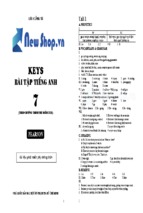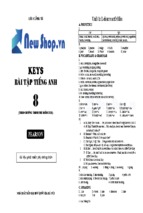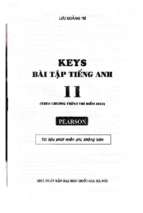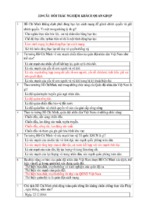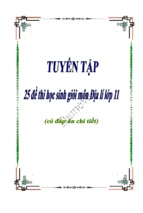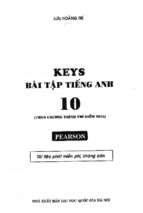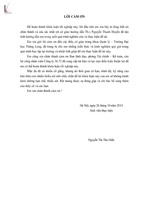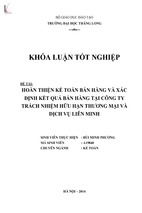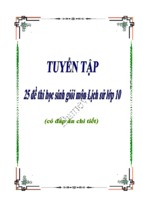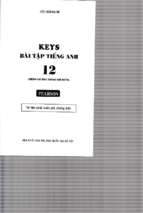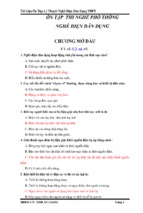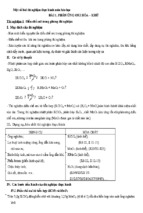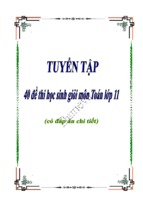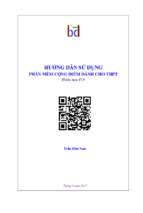THI THỬ CÙNG CHUYÊN KHTN HÀ NỘI
Đề chính thức
ĐỀ THI THỬ MÔN TIẾNG ANH - ĐỀ SỐ 06
Thời gian làm bài: 90 phút (không kể thời gian đọc đề)
Câu 1 (1 điểm)
Mark the letter A, B, C, or D on your answer sheet to indicate the word whose underlined
part differs from the other three in pronunciation in each of the following questions.
A. crumble
B. ceramic
C. cover
D. economy
Câu 2 (1 điểm)
Mark the letter A, B, C, or D on your answer sheet to indicate the word whose underlined
part differs from the other three in pronunciation in each of the following questions.
A. plough
B. enough
C. graph
D. coughing
Câu 3 (1 điểm)
Mark the letter A, B, C, or D on your answer sheet to indicate the word that differs from
the other three in the position of the primary stress in each of the following questions.
A. tunnel
B. nightmare
C. retain
D. thesis
Câu 4 (1 điểm)
Mark the letter A, B, C, or D on your answer sheet to indicate the word that differs from
the other three in the position of the primary stress in each of the following questions.
A. rainfall
B. inquire
C. confide
D machine
Câu 5 (1 điểm)
Mark the letter A, B, C, or D on your answer sheet to indicate the word that differs from
the other three in the position of the primary stress in each of the following questions.
A. tableland
B. artistic
C. contribute
D. substantial
Câu 6 (1 điểm)
Mark the letter A, B, C, or D on your answer sheet to indicate the word that differs from
the other three in the position of the primary stress in each of the following questions.
A. tableland
B. artistic
C. contribute
D. substantial
Câu 7 (1 điểm)
Mark the letter A, B, C or D on your answer sheet to indicate the correct answer to each of
the following questions.
Havy: “Thanks for your help, Judy.”
Judy: “______.”
A. With all my heart
B. Never remind me
C. It’s my pleasure
D. It's ok
Câu 8 (1 điểm)
"Just think, ______ 2 years' time, we'll be 20 both."
A. under
B. in
C. less than
D. over
Câu 9 (1 điểm)
Anne persisted ______ her search for the truth about what had happened.
A. at
B. about
C. on
D. in
Câu 10 (1 điểm)
If she ______ sick, she would have gone out with me to the party.
A. wasn’t
B. hadn’t been
C. hasn’t been
D. weren’t
Câu 11 (1 điểm)
“Would you mind lending me your bike?”
- “ ______ .”
A. Yes. Here it is
B. Not at all
C. Great
D. Yes, let’s
Câu 12 (1 điểm)
. ______ entering the hall, he found everyone waiting for him
A. With
B. On
C. At
D. During
Câu 13 (1 điểm)
- “Has an announcement been made about the eight o’clock flight to Paris?”
- “ _______.”
A. Not yet
B. Yes, it was
C. I don’t think that
D. Sorry, it hasn't
Câu 14 (1 điểm)
You should at least ................ an effort to find the boy's address if you don't want to lose your last hope.
A. do
B. work
C. put
D. make
Câu 15 (1 điểm)
We are going to build a fence around the field with a view to ........... sheep and cattle.
A. be breeding
B. breed
C. bred
D. breeding
Câu 16 (1 điểm)
Everyone can join our club, ...................... age and sex.
A. not mention
B. in case of
C. in place of
D. regardless of
Câu 17 (1 điểm)
The polar bear's .................... depends on its ability to catch fish.
A. survival
B. survive
C. surviving
D. survivor
Câu 18 (1 điểm)
"Do you like pop music or jazz?" "I don't like .................... of them. I prefer classical music."
A. either
B. neither
C. both
D: any
Câu 19 (1 điểm)
"Do you like pop music or jazz?" "I don't like .................... of them. I prefer classical music."
A. either
B. neither
C. both
D: any
Câu 20 (1 điểm)
It was so foggy that the driver couldn't ...................... the traffic signs.
A. make out
B. break out
C. keep out
D. take out
Câu 21 (1 điểm)
She'd rather I .................... to the party with her yesterday.
A. had to go
B. to have gone
C. went
D. had gone
Câu 22 (1 điểm)
Jane returned the borrowed book___________.
A. the very day next
B. the day very next
C. the very next day
D. the next very day
Câu 23 (1 điểm)
The growth of two-income families in the US _____ of people moving to a new social class.
A. has resulted in millions
B. result in millions
C. results of millions
D. millions of results
Câu 24 (1 điểm)
The door is unlocked; _______ here last night.
A. Something strange was happened
B. Something strange should have happened
C. Something strange had happened
D. Something strange could have happened
Câu 25 (1 điểm)
Although he supports the Council, he does not take an active _______ in politics.
A. affair
B. role
C. part
D. charge
Câu 26 (1 điểm)
In mathematics, a variable is a symbol_______ some elements of a set.
A. represents that
B. that represents
C. represents
D. and representing
Câu 27 (1 điểm)
In the West, the birth of a girl is welcome with an enthusiasm ____ to that of a boy.
A. and equal
B. equal
C. equally
D. are equal
Câu 28 (1 điểm)
Mark the letter A, B, C or D on your answer sheet to indicate the word(s) SIMILAR in
meaning to the underlined word(s) in each of the following questions.
These shoes are made of imitation leather
A. natural
B. man-made
C. valuable
D. expensive
Câu 29 (1 điểm)
The naughty boy was scolded yesterday.
A. told off
B. complimented
C. caught
D. beaten
Câu 30 (1 điểm)
In the 1920s, amateur theatre performances benefited poor families and other charitable causes.
A. untrained
B. inexperienced
C. non-profit
D. non-professional
Câu 31 (1 điểm)
The widespread use of pesticides and herbicides has led to contamination of groundwater in some areas.
A. extensive
B. experimental
C. occasional
D. general
Câu 32 (1 điểm)
When we travel overseas, we hope to go to Iceland.
A. on the sea
B. by water
C. with foreigners
D. to foreign lands
Câu 33 (1 điểm)
Mark the letter A, B C or D on your answer sheet to indicate the underlined part that
needs correction in each of the following questions.
The science and technology industries have grown up steadily over the last decade.
A
A
B
C
D
Câu 34 (1 điểm)
B
C
D
Thanks to new techniques, canning goods now have a much longer shelf life.
A
B
C
D
A
B
C
D
Câu 35 (1 điểm)
Originated in Ethiopia, coffee was drunk in the Arab world before it came to Europe in the
A
B
C
D
17th century.
A
B
C
D
Câu 36 (1 điểm)
Some people believe that human being will never use off all the natural resources on earth.
A
B
C
D
A
B
C
D
Câu 37 (1 điểm)
Because vitamins are contained in a wide variety of foods, people seldom lack of most of
A
B
C
them.
A
B
C
D
Câu 38 (1 điểm)
Read the following passage and mark the letter A, B, C, or D on your answer sheet to
D
indicate the correct word or phrase that best fits each of the numbered blanks.
The first American immigrants, beginning more than 20,000 years ago, were intercontinental wanderers:
hunters and their families following animal (36)______ from Asia to America, across a land bridge where
the Bering Strait is today. (37)______ Spain’s Christopher Columbus “discovered” the New World in
1492, about 1.5 million Native Americans lived in what is now the continental United States, although
estimates of the number (38)______ greatly. Mistaking the place where he landed – San Salvador in the
Bahamas – (39)______ the Indies, Columbus called the Native Americans “Indians.”
During the next 200 years, people from several European countries followed Columbus across the
Atlantic Ocean to explore America and (40)______ up trading posts and colonies. Native Americans
suffered (41)______ from the influx of Europeans. The transfer of land from Indian to European – and
later American – hands (42)______ accomplished through treaties, wars, and coercion, with Indians
constantly giving (43)______ as the newcomers moved west. In the 19th century, the government’s
preferred solution to the Indian “problem” was to force tribes to inhabit specific plots of land called
reservations. Some tribes fought to keep from (44)______ land they had traditionally used. In many cases
the reservation land was (45)______ poor quality, and Indians came to depend on government assistance.
Poverty and joblessness among Native Americans still exist today (36)
A. herds
B. bunches
C. flocks
D. packs
Câu 39 (1 điểm)
(37)
A. When
B. During
C. Not until
D. Meanwhile
Câu 40 (1 điểm)
(38)
A. modify
B. adjust
C. vary
D. adapt
Câu 41 (1 điểm)
(39)
A. like
B. for
C. to
D. with
Câu 42 (1 điểm)
(40)
A. go
B. make
C. bring
D. set
Câu 43 (1 điểm)
(41)
A. greatly
B. marginally
C. deliberately
D. vaguely
Câu 44 (1 điểm)
(42)
A. was
B. were
C. have been
D. had been
Câu 45 (1 điểm)
(43)
A. road
B. way
C. direction
D. signal
Câu 46 (1 điểm)
(44)
A. staying up
B. breaking down
C. coming about
D. giving up
Câu 47 (1 điểm)
(45)
A. with
B. of
C. under
D. in
Câu 48 (1 điểm)
Read the following passage and mark the letter A, B, C or D on your answer sheet to
indicate the correct answer to each of the questions from 46 to 55.
As the twentieth century began, the importance of formal education in the United States increased. The
frontier had mostly disappeared and by 1910 most Americans lived in towns and cities. Industrialization
and the bureaucratization of economic life combined with a new emphasis upon credentials and expertise
to make schooling increasingly important for economic and social mobility. Increasingly, too, schools
were viewed as the most important means of integrating immigrants into American society.
The arrival of a great wave of southern and eastern European immigrants at the turn of the
century coincided with and contributed to an enormous expansion of formal schooling. By 1920
schooling to age fourteen or beyond was compulsory in most states, and the school year was greatly
lengthened. Kindergartens, vacation schools, extracurricular activities, and vocational education and
counseling extended the influence of public schools over the lives of students, many of whom in the
larger industrial cities were the children of immigrants. Classes for adult immigrants were sponsored by
public schools, corporations, unions, churches, settlement houses, and other agencies.
Reformers early in the twentieth century suggested that education programs should suit the needs
of specific populations. Immigrant women were once such population. Schools tried to educate young
women so they could occupy productive places in the urban industrial economy, and one place many
educators considered appropriate for women was the home.
Although looking after the house and family was familiar to immigrant women, American
education gave homemaking a new definition. In preindustrial economies, homemaking had meant the
production as well as the consumption of goods, and it commonly included income-producing activities
both inside and outside the home, in the highly industrialized early-twentieth-century United States,
however, overproduction rather than scarcity was becoming a problem. Thus, the ideal American
homemaker was viewed as a consumer rather than a producer. Schools trained women to be consumer
homemakers cooking, shopping, decorating, and caring for children "efficiently" in their own homes, or if
economic necessity demanded, as employees in the homes of others. Subsequent reforms have made these
notions seem quite out-of-date.
(46) The paragraph preceding the passage probably discusses
A. the urbanization in the United States in the nineteen century
B. the industrialization and the bureaucratization of economic life the United States in the nineteen century.
C. the formal schooling in the United States in the nineteen century
D. the most important means of integrating immigrants into American society in 19 th century
Câu 49 (1 điểm)
It can be inferred from paragraph 1 that one important factor in the increasing importance of education in
the United States was
A. the growing number of schools in frontier communities
B. an increase in the number of trained teachers
C. the expanding economic problems of schools
D. the increased urbanization of the entire country
Câu 50 (1 điểm)
The word "means” in line 5 is closest in meaning to
A. advantages
B. probability
C. method
D. qualifications
Câu 51 (1 điểm)
The phrase "coincided with” in line 7 is closest in meaning to
A. was influenced by
B. happened at the same time as
C. began to grow rapidly
D. ensured the success of
Câu 52 (1 điểm)
According to the passage, one important change in the US education by the 1920's was that
A. most places required children to attend school
B. the amount of time spent on formal education was limited
C. new regulations were imposed on nontraditional education
D. adults and children studied in the same classes
Câu 53 (1 điểm)
Vacation schools and extracurricular activities are mentioned in line 9 to illustrate
A. alternatives to formal education provided by public schools
B. the importance of educational changes
C. activities that competed to attract new immigrants to their programs
D. the increased impact of public schools on students
Câu 54 (1 điểm)
According to the passage, early-twentieth century education reformers believed that
A. different groups needed different kinds of education
B. special programs should be set up in frontier communities to modernize them
C. corporations and other organizations damaged educational progress
D. more women should be involved in education and industry
Câu 55 (1 điểm)
The word "it” in the last paragraph refers to
A. consumption
B. production
C. homemaking
D. education
Câu 56 (1 điểm)
Women were trained to be consumer homemakers as a result of
A. overproduction in the highly industrialized early-twentieth-century United States
B. scarcity in the highly industrialized early-twentieth-century United States
C. economic necessity in the highly industrialized early-twentieth-century United States
D. income-producing activities in the highly industrialized early-twentieth-century United States
Câu 57 (1 điểm)
Which paragraph mentions the importance of abilities and experience in formal schooling?
A. Paragraph 1
B. Paragraph 2
C. Paragraph 3
D. Paragraph 4
Câu 58 (1 điểm)
Read the following passage and mark the letter A, B, C or D on your answer sheet to
indicate the correct answer to each of the questions from 56 to 65.
Ranked as the number one beverage consumed worldwide, tea takes the lead over coffee in both
popularity and production with more than 5 million metric tons of tea produced annually. Although much
of this tea is consumed in Asian, European, and African countries, the United States drinks its fair share.
According to estimates by the Tea Council of the United States, tea is enjoyed by no less than half of the
U.S. population on any given day. Black tea or green tea – iced, spiced, or instant – tea drinking has
spurred a billion-dollar business with major tea producers in Africa and South America and throughout
Asia.
Tea is made from the leaves of an evergreen plant, Camellia sinensis, which grows tall and lush in tropical
regions. On tea plantation, the plant is kept trimmed to approximately four feet high and as new buds
called flush appear, they are plucked off by hand. Even in today’s world of modern agricultural
machinery, hand harvesting continues to be the preferred method. Ideally, only the top two leaves and a
bud should be picked. This new growth produces the highest quality tea.
After being harvested, tea leaves are laid out on long drying racks, called withering racks, for 18 to 20
hours. During this process, the tea softens and becomes limp. Next, depending on the type of tea being
produced, the leaves may be crushed or chopped to release flavor, and then fermented under controlled
conditions of heat and humidity. For green tea, the whole leaves are often steamed to retain their green
color, and the fermentation process is skipped. Producing black teas requires fermentation during which
the tea leaves begin to darken. After fermentation, black tea is dried in vats to produce its rich brown or
black color.
No one knows when or how tea became popular, but legend has it that tea as a beverage was discovered
in 2737 B.C. by Emperor Shen Nung of China when leaves from a Camellia dropped into his drinking
water as it was boiling over a fire. As the story goes, Emperor Shen Nung drank the resulting liquid and
proclaimed the drink to be most nourishing and refreshing. Though this account cannot be documented, it
is thought that tea drinking probably originated in China and spread to other parts of Asia, then to Europe,
and ultimately to America colonies around 1650.
With about half the caffeine content as coffee, tea is often chosen by those who want to reduce, but not
necessarily eliminate their caffeine intake. Some people find that tea is less acidic than coffee and
therefore easier on the stomach. Others have become interested in tea drinking since the National Cancer
Institute published its findings on the antioxidant properties of tea. But whether tea is enjoyed for its
perceived health benefits, its flavor, or as a social drink, teacups continue to be filled daily with the
world’s most popular beverage.
(56) Why does the author include statistics on the amount of tea produced, sold, and consumed?
A. To demonstrate tea’s popularity
B. To show the expense of processing such a large quantity of tea
C. To explain why coffee is not the most popular beverage worldwide
D. To impress the reader with factual sounding information
Câu 59 (1 điểm)
Based on the passage, what is implied about tea harvesting?
A. The method has remained nearly the same for a long time.
B. It is totally done with the assistance of modern agricultural machinery
C. It is no longer done in China
D. The method involves trimming the uppermost branches of the plant
Câu 60 (1 điểm)
What does the word “they” in paragraph 2 of the passage refer to_____?
A. new buds
B. tropical regions
C. tea pickers
D. evergreen plants
Câu 61 (1 điểm)
Which of the following is NOT true about the tea production process?
A. Black tea goes through two drying phases during production
B. Black tea develops its dark color during fermentation and final drying
C. Green tea requires a long fermentation process
D. Green tea is often steamed to keep its colo
Câu 62 (1 điểm)
The word “documented” in paragraph 4 could be best replaced by which of the following?
A. kept
B. proved
C. stored
D. ignored
Câu 63 (1 điểm)
According to the passage, what is true about the origin of tea drinking?
A. It began during the Shen Nung dynasty
B. It may have begun some time around 1650
C. It is unknown when tea first became popular
D. It was originally produced from Camillia plants in Europe
Câu 64 (1 điểm)
The word “eliminate” in paragraph 5 could be best replaced by which of the following?
A. increase
B. reduce
C. decrease
D. remove
Câu 65 (1 điểm)
According to the passage, which may be the reason someone would choose to drink tea instead of coffee?
A. Because it’s easier to digest than coffee
B. Because it has a higher nutritional content than coffee
C. Because it helps prevent cancer
D. Because it has more caffeine than coffee
Câu 66 (1 điểm)
Where in the passage does the author mention research conducted on the beneficial effects of tea
drinking?
A. The two most popular types of tea
B. How tea is produced and brewed
C. The benefits of tea consumption worldwide
D. Tea consumption and production
Câu 67 (1 điểm)
WRITING
Part I. Finish each of the following sentences in such a way that it means the same as the
sentence printed before it.
(66) We were very impressed by the new cinema but found it rather expensive.
Impressed ___________________________________________.
Câu 68 (1 điểm)
I shall never lend Robert any more money, no matter what happens.
Under no ___________________________________________.
Câu 69 (1 điểm)
It's more than a fortnight since anyone saw Julian.
Julian was___________________________________________.
Câu 70 (1 điểm)
The only thing that prevented the passing of the bill was the death of the Prime Minister.
Had it not ____________________________________________.
Câu 71 (1 điểm)
In order to make a profit the new leisure center needs at least 2,000 visitors a month.
No fewer _______________________________________________.
Câu 72 (1 điểm)
Part II. In some countries, teenagers have jobs while they are still students. Do you think it's a good idea?
Write about 180 words to support your opinion.
- Xem thêm -


